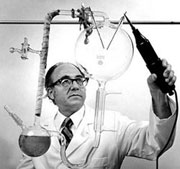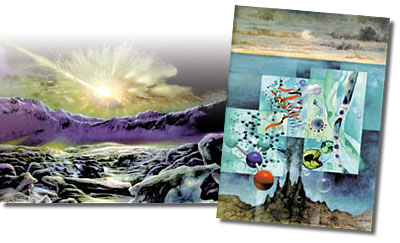 |
Miller with his experiment apparatus |
 |
MILLER'S CONFESSION: Today, Miller too accepts that his 1953 experiment was very far from explaining the origin of life. |
American chemist Stanley Miller conducted an experiment in 1953 to support the scenario of molecular evolution. Miller assumed that the primordial earth atmosphere was composed of methane, ammonia, and hydrogen gases. He combined these gases in an experiment set-up and gave electricity to the mixture. Almost a week later, he observed that some amino acids formed in this mixture.
This discovery aroused great excitement among evolutionists. In the next twenty years, some evolutionists, such as Sydney Fox and Cyril Ponnamperuma, attempted to develop Miller's scenario.
The discoveries made in the 1970's repudiated these evolutionist attempts known as "primordial atmosphere experiments". It was revealed that the "methane-ammonia based primordial atmosphere model" Miller proposed and other evolutionists accepted was absolutely fallacious. Miller chose these gases on purpose, because they were very convenient for the formation of amino acids. Scientific discoveries, on the other hand, showed that the primordial atmosphere was composed of nitrogen, carbon dioxide and water vapour.14 This atmosphere model was by no means suitable for the formation of amino acids. Moreover, it was understood that a great amount of oxygen naturally occurred in the primordial atmosphere.15 This, too, invalidated the scenario of the evolutionists, because free oxygen would obviously decompose amino acids.
 | PRIMORDIAL ATMOSPHERE MISCONCEPTION Miller claimed that he strictly reproduced the primordial atmosphere conditions in his experiment. However, the gases Miller used in his experiment were not even remotely comparable to the real primordial earth conditions. Moreover, Miller had interfered in the experiment with purposeful mechanisms. In fact, with this experiment, he himself refuted the evolutionist claims that amino acids could have formed spontaneously in natural conditions. |
As a result of these discoveries, the scientific community acknowledged in the 1980's that Miller's Experiment and other "primordial atmosphere experiments" that followed it have no meaning at all. After a long silence, Miller also confessed that the atmosphere medium he used was unrealistic.16
 | FOX'S UNSUCCESSFUL EXPERIMENT Inspired by Miller's scenario, evolutionists conducted different experiments in the years that followed. Sydney Fox produced the molecules seen in the picture, "proteinoids" as he called them, by combining some amino acids. These useless amino acid chains had nothing to do with real proteins that constitute the bodies of living things. Actually, all these efforts not only showed that life did not come about by coincidence, but also that it could not be reproduced in laboratory conditions. |
What's more, this whole fuss was simply about "amino acid formation". Even if amino acids had formed, it is impossible for these simple organic molecules to give rise to extremely complex structures such as proteins by chance and produce a living cell which even mankind is unable to reproduce in laboratories today.
The fifty years that have passed since Miller's time have only served to further display the despair the theory of evolution faces at the molecular level.
| MILLERS VORAUSSETZUNGEN | REAL CONDITIONS | WHY IS THE EXPERIMENT INVALID? |
|---|---|---|
| He used methane, ammonia, and water vapour in the experiment. | Primitive earth contained carbon dioxide and nitrogen instead of methane and ammonia. | Ferris and Chen from the USA repeated the experiment with the gases that existed at that time. Not even one amino acid was obtained. |
| He assumed oxygen to be non-existent in the primitive atmosphere. | Findings show that there was a huge amount of free oxygen in the primitive atmosphere. | With such an amount of free oxygen available, the amino acids would have broken down, even if they could have been formed. |
| mechanism set up to synthesize the amino acids in the experiment. This mechanism, called the "Cold Trap", isolated the amino acids from the environment as soon as they were formed and preserved them. | It was impossible for these kinds of mechanisms to have existed in nature. Under natural conditions, amino acids are exposed to all kinds of external destructive factors. | If the mechanism known as the "Cold Trap" had not existed, the spark source and other chemicals released during the experiment would have destroyed the amino acids. |
14) J. S. Ferris, C. T. Chen, "Photochemistry of Methane, Nitrogen, and Water Mixture As a Model for the Atmosphere of the Primitive Earth", Journal of American Chemical Society, Bd. 97:11, 1975, S. 2964
15) "New Evidence on Evolution of Early Atmosphere and Life", Bulletin of the American Meteorological Society, Bd. 63, November 1982, S. 1328 ff.
16) Colin Patterson, "Cladistics", BBC, Interview mitBrian Leek, Peter Franz, 4 März 1982